The future of heavy duty diesel engine oils
Jeanna Van Rensselar, Senior Feature Writer | TLT Webinars March 2016
20 MPG in a heavy duty truck? It’s do-able
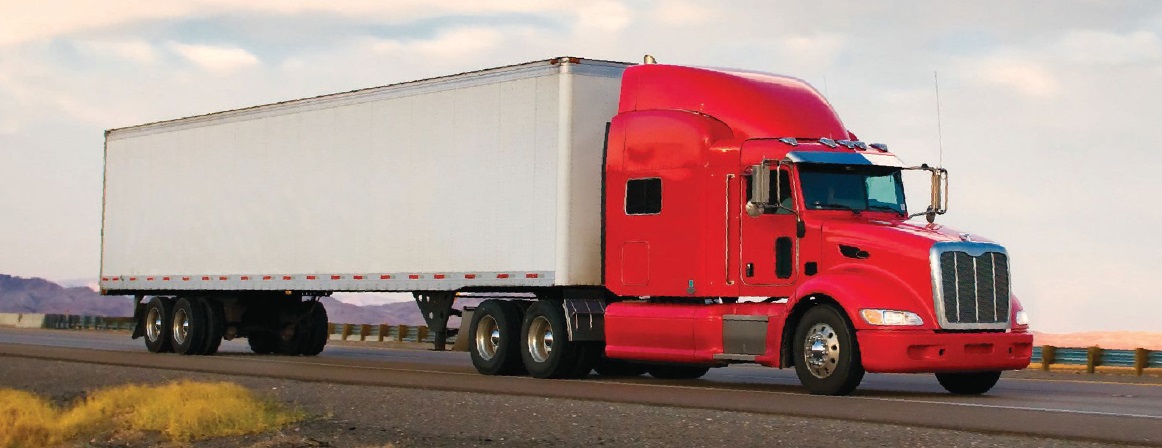
© Can Stock Photo Inc. / javarman
KEY CONCEPTS
•
For PC-11s, high temperature/high shear viscosity is the main determinant in fuel economy performance.
•
One of the primary challenges with lower viscosity fuel efficient lubricants is providing adequate engine protection.
•
Analysis of used PC-11 oil is important to ensure the correct oil is being used and to monitor wear metals, an issue with PC-11B oils in older engines.
MEET THE PRESENTER
This article is based on a Webinar presented by STLE University on Oct. 14, 2015. The Future of Heavy Duty Diesel Engine Oils is available at
www.stle.org: $39 to STLE members, $59 for all others.
Shawn McCarthy graduated from Franklin Pierce University with a bachelor’s of arts degree in economics and a bachelor’s of science degree in environmental science. He has been an outside sales representative for Ocean State Oil for the past 16 years, with a customer base including companies from the commercial, industrial, automotive and marine sectors. McCarthy carries STLE’s Certified Lubrication Specialist™ and Oil Monitoring Analyst™ (OMA I) certifications and has been a TLT technical editor for the past two years. He recently became a member of the society’s OMA Committee. You can reach Shawn at
shawn.mccarthy@oceanstateoil.com.
 Shawn McCarthy
Shawn McCarthy
IN 2010 THE NATIONAL HIGHWAY TRAFFIC SAFETY ADMINISTRATION announced regulations to reduce the level of greenhouse gas (GHG) (CO
2) emissions and mandate fuel economy improvements for medium and heavy duty (HD) engines and vehicles (
see Emission and Fuel Efficiency Targets). For on-road diesel vehicles, the new regulations—which are being phased in from 2014-2018—impose fuel-efficiency targets that are based on the vehicle’s size and weight. Stricter GHG regulations will be enforced in 2017.
EMISSIONS AND FUEL EFFICIENCY TARGETS
•
2017 models must reduce CO
2 emissions by 10%-20% over their 2010 baseline.
•
2017 class 7 and class 8 trucks must save four more gallons of fuel for every 100 miles traveled over their 2010 baseline.
•
EPA is targeting a 9%-23% improvement in fuel economy and carbon emissions for larger trucks and a 6%-9% improvement in vocational and medium-duty trucks.
•
The national and global goal for fuel efficiency in HD trucks is an average of about 20 MPG in the next 15-35 years.
This article is based on an STLE University-sponsored Webinar presented Oct. 14, 2015, by Shawn McCarthy, an outside sales representative for Ocean State Oil. See Meet the Presenter for details on the Webinar and how you can download a version.
The American Petroleum Institute’s (API) Proposed Category 11 (PC-11) refers to a new generation of heavy duty engine oils that will facilitate compliance with the new regulations (
see Links to PC-11 Information). The proposed date of first license for PC-11 oils is late 2016 and first availability is expected in December.
LINKS TO PC-11 INFORMATION
The following Websites have good information about PC-11 and its integration into the heavy duty vehicle market:
www.pc-11explained.com
www.hddeo.com
www.infineuminsight.com/expertise/heavy-duty-engine-oils
www.whatispc-11.com
To comply with these new regulations, significant diesel engine design changes include:
•
Diesel engine downsizing—15 L to 13 L
•
Down speeding—1,600 rpm to 1,200 rpm
•
Advanced combustion design
•
Active oil temperature control
•
Variable valve timing
•
Start/stop technology (
1).
The new PC-11 diesel engine oils will play a pivotal role in supporting new design changes and complying with new regulations by enabling these design advancements, increasing fuel economy through lower viscosity grades and friction modifiers and improving engine durability through advanced additive formulations and careful base oil selection.
There is no fuel economy test for PC-11. Since the fuel economy savings will be derived primarily from lower viscosity oil, the challenge for oil formulators is developing low-viscosity oils that still provide the necessary engine protection (
see Benefits of Low-Viscosity Oils). But oxidation stability will be the main performance upgrade because the oil also must be thermally stable in order to prevent oxidation, which leads to deposit formation and reduced fuel economy (
see The Oxidation Process).
BENEFITS OF LOW-VISCOSITY OILS
•
Approximate 1% fuel savings with SAE 10W-30 oils (over SAE 15W-40)
•
Approximate 2% fuel savings with SAE 5W-30 oils (over SAE 15W-40)
•
Engine oil drain and durability are equal to SAE 15W-40 engine oils in most cases.
THE OXIDATION PROCESS
Catalysts for the oxidation process include temperature, wear metals, water-free and dissolved contaminants, UV light and oxygen. There are three stages in the oxidation process:
1.
Initiation (when the process begins)
2.
Propagation (as the process intensifies)
3.
Termination (when the process ends, either positively or negatively).
The consequences of negative reactions include corrosion and wear; an increase in oil viscosity; the formation of sludge and varnish; filter plugging; accelerated wear rates, higher operating temperatures; additive depletion; and base oil breakdown.
PC-11 CATEGORIES AND TESTS
For the first time, PC-11 will be split into two categories: PC-11A and PC-11B. Following are some specifics on each.
PC-11 A
•
Licenses as API CK-4 on Dec. 1, 2016
•
Is backward compatible with API CJ-4, API CI-4+, etc.
•
Covers W-40 and W-30 viscosity grades
•
Minimum 3.5 centipoise high temperature/high shear (cPHT/HS)
•
Has the same limits on sulfur, phosphorus and sulfated ash as CJ-4
•
Is compatible with after-treatment systems.
PC-11 B
•
Licenses as API FA-4 on Dec. 1, 2016
•
Has limited or no backward compatibility—any backward compatibility depends on the OEM
•
Covers only W-30 viscosity grade
•
Has a viscosity range between 2.9-3.2 cPHT/HS
•
Has improved fuel economy compared to API CJ-4 and PC-11A oils
•
Has the same limits on sulfur, phosphorus and sulfated ash as CJ-4
•
Is compatible with after-treatment systems.
Right now there are nine engine oil tests; the first seven are legacy tests and the last two, Volvo T-13 and Cat C13-A, are new (
see Figure 1):
•
Cat 1N. Tests for aluminum piston deposits.
•
GM 6.5L. Tests for valve train wear.
•
Cummins ISB. Tests for valve train wear.
•
Cummins ISM. Tests for valve train wear, sludge and filter plugging.
•
Cat C13. Tests for steel piston deposits in oil consumption.
•
Mack T-11. Tests for soot dispersants.
•
Mack T-12. Tests for ring liner wear, protection of lead alloy bearings and measures oxidation resistance.
•
Volvo T-13. Tests for oxidation and bearing corrosion.
•
Cat C13-A. Tests for aeration; PC-11 oils need to have better aeration properties to support new engine designs.
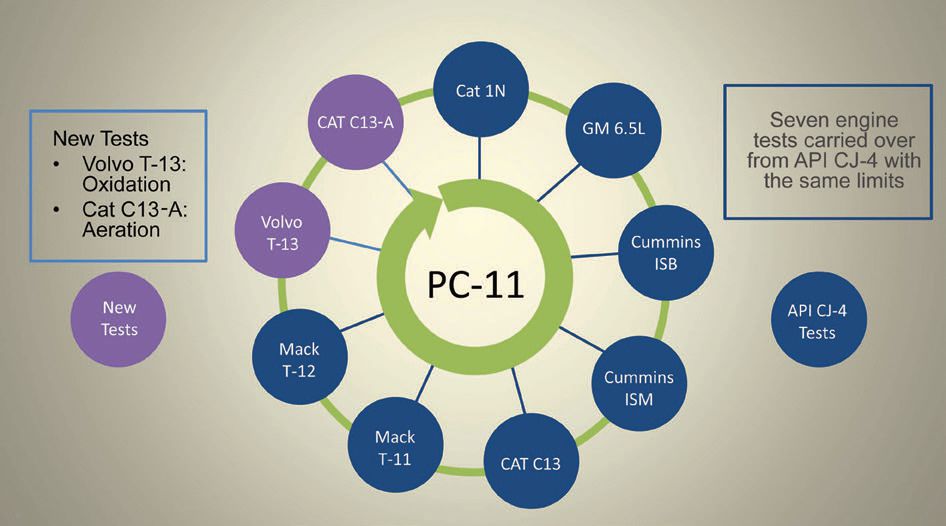 Figure 1. The first seven engine oil tests are legacy ones and the last two, Volvo T-13 and Cat C13-A, are new.
BASE OIL AND BOI/VGRA
Figure 1. The first seven engine oil tests are legacy ones and the last two, Volvo T-13 and Cat C13-A, are new.
BASE OIL AND BOI/VGRA
Base oil interchange (BOI) is the process of interchanging one base oil for another without having to test the formulation again as long as it has the same basic additive package. Viscosity grade read across (VGRA) is a guideline used to test a formulation in one viscosity grade and apply the results to a different grade without additional engine testing. This is helpful in streamlining multiple formulations. Both BOI and VGRA allow products to get to the market rapidly—benefiting formulators, OEMs and consumers. But there are two concerns with BOI and VGRA:
1.
The test data may not support the in-use results, which can create a negative situation for the end-user.
2.
The BOI can make it difficult to quantify highly refined oils. Lack of physical and chemical tests to measure the traits that improve performance in the engine have not been identified for BOI in highly refined oils.
PC-11 requires a high-quality, high-VI base oil in one of the three groups in Table 1.
•
Group II and III are prevalent. Both groups have advantages over Group I and Group IV (synthetics) and over each other (
2).
•
Group II oils have less sulfur, a higher VI, more saturates (better oxidation properties) and a clearer color than Group I. They also have better solvency (soot dispersancy), processing advantages and a lower cost than Group III.
•
Group III oils have a better pour point, better oxidation and thermal stability, better cold crank performance and a higher VI than Group II. Some also have better additive solubility, antiwear performance, lubricity, pour point and supply and a lower cost than Group IV oil.
Table 1. Base Oil Properties
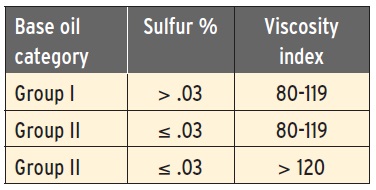 PC-11 ADDITIVES
PC-11 ADDITIVES
There is some overlap in additive systems for PC-11A and PC-11B. Most PC-11 oils typically include three primary classes of additives: VI improvers (may be most important), friction modifiers and antioxidants.
VI IMPROVERS
These account for 23% of all additive sales. They provide engine protection for low-temperature starts and high-operating temperatures and must have shear stability. The five basic functions of viscosity modifiers include:
1.
Reducing viscosity changes with temperature
2.
Enabling the engine to start at low temperatures
3.
Ensuring engine durability during boundary layer lubrication regimes
4.
Providing non-viscometric performance benefits
5.
Providing protection and better operation for a secondary usage of engine oil including removing contaminants to the filter, preventing rust and corrosion and in some cases transmitting power.
For PC-11, high temperature/high shear viscosity is the main determinant of fuel economy performance (
see Successes With PC-11).
SUCCESSES WITH PC-11
Ryder. Ryder recently switched its fleet of 200,000 trucks and tractors from SAE 15W-40 to SAE 10W-30. They expect 1.5% better fuel economy and a reduction of 110,000 metric tons of CO
2 without changing any maintenance procedures.
Infineum. Infineum tested 2.1 cPHT/HS viscosity oil in a high-soot-producing Cummins ISX 450 HP. There were no significant differences compared to SAE 15W-40 in terms of oil consumption, used wear metals and parts consumption. They also reported that an engine using SAE 5W-30 with new additive technology in a Cummins ISX 450 successfully completed 1,000,000 miles.
Shell. Shell has logged in 22 million miles on 14 engines with PC-11 type oils. The longest running was 800,000 miles. One engine ran 500,000 miles with a 3.0cP 10W-30 oil. Drain intervals were 55,000 miles.
FRICTION MODIFIERS
Friction modifiers (FMs) are crucial during boundary lubrication and reduce the effect of friction on the metal surface. They improve fuel economy of the oil and are an effective performance additive. There are two types of FMs—organic friction modifiers and metal-containing friction modifiers. Both have two segments: a polar group and an oleophilic group.
ANTIOXIDANTS
•
Sacrificial antioxidants deplete over time. They include UV absorbers, peroxide decomposers, chain-breaking electron donors and chain-breaking electron acceptors.
•
Primary antioxidants include phenolic or aromatic amines, chain-breaking antioxidants and free radical-absorbing antioxidants (able to stop more than one free radical).
•
Secondary antioxidants include peroxide decomposers (ZDDPs).
In addition to the three primary categories, other major additives include dispersants, detergents, pour point depressants, foam inhibitors and antiwear additives. Following is the range of additive treat rates for HD engine oil:
•
Ashless dispersants: 8%-12%
•
VI improvers: 0%-10%
•
Detergents: 2%-3%
•
Antioxidants: 0.3%-1.5%
•
Antiwear additives: 1%-1.5%
•
Friction modifiers 0.1%-0.5%
•
Others: 1%-2%.
SOME CHALLENGES
First of all, ZDDPs, while cost effective, contain phosphorus, which has a 1,200 ppm limit (800 ppm for gasoline engines). Ashless antiwear additives improve performance but have limited field results and may need to be supplemented with other additives. Formulators also need to convince end-users that low-viscosity oils perform as well as SAE 15W-40 oils. Some PC-11s may no longer carry gasoline approvals, and end-users may need to stock additional oil inventory as they purchase new trucks (
see Did You Know?).
DID YOU KNOW?
•
Transportation accounts for 41% of the total energy used in the U.S.
•
In 2008 HD trucks accounted for 22% of greenhouse gas emissions in the U.S.
•
There were 3.6 million class 8 trucks in 2015 with four million projected by 2026.
•
Diesel fuel cost accounts for about 40% of the total cost of operating over-the-road class 8 trucks in North America.
These are all challenges, but ensuring that correct oils are used is a major challenge that, if not carried out, can have consequences leading to engine failure.
So what can be done to ensure that the wrong oil is not used? The primary tool is education. A number of Websites provide excellent resources (
see Links to PC-11 Information). Another critical source of information is the oil label—on the container and/or the storage tank (
see Figure 2).
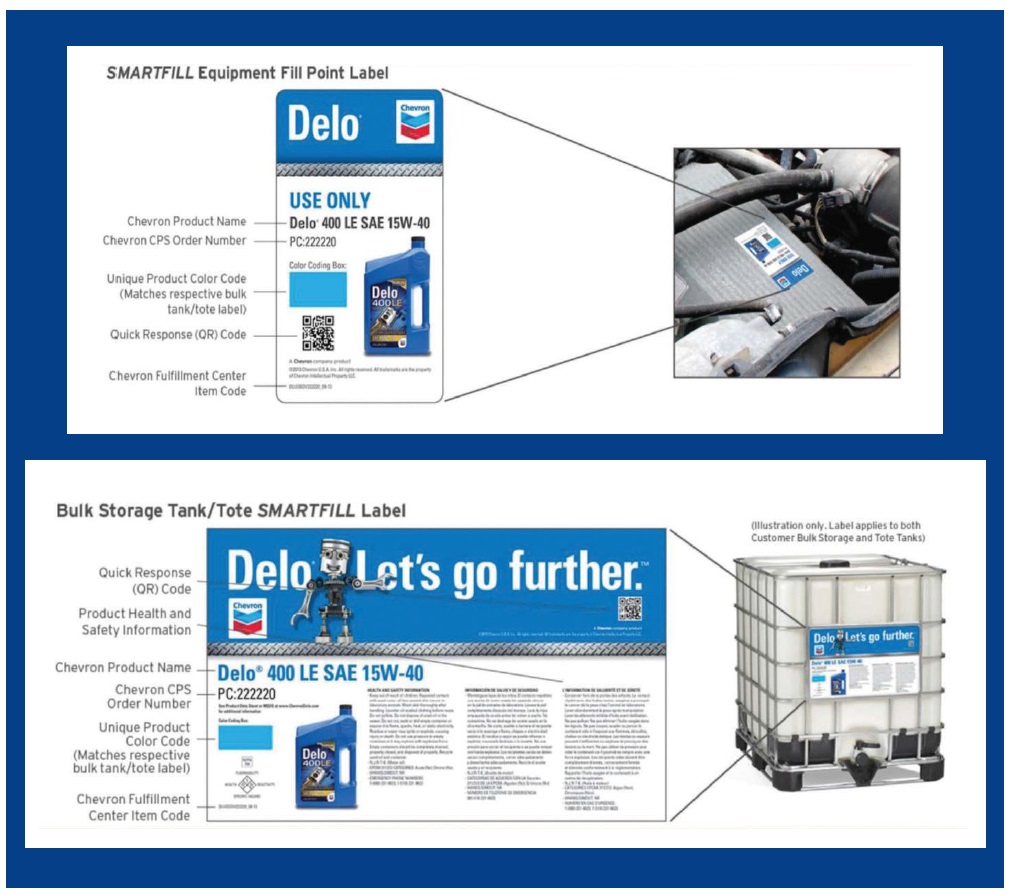 Figure 2. Chevron’s SMARTFILL label program.
OIL ANALYSIS
Figure 2. Chevron’s SMARTFILL label program.
OIL ANALYSIS
So what is all of this going to mean for oil analysis providers? Used oil analysis will be even more beneficial for two reasons:
•
To ensure that the correct oil is being used
•
To test for wear metals (low-viscosity PC-11s in older engines have the potential to cause premature wear).
The biggest concern end-users have is how well low-viscosity oils are going to hold up. Because of this and other factors, it will take the market a while to accept these oils. But lower viscosity oils are here to stay. CAT, John Deere, Volvo and Kenworth currently factory fill with SAE 10W-30, which is projected to gain 28% of the market share by 2021 and 50% of the market share by 2025 (
see Figure 3). According to the Shell PC-11 Website, if every truck increased fuel economy by just 1%, it would result in an annual reduction of four million tons of carbon dioxide emissions, the equivalent of removing 23,000 trucks from the road each year.
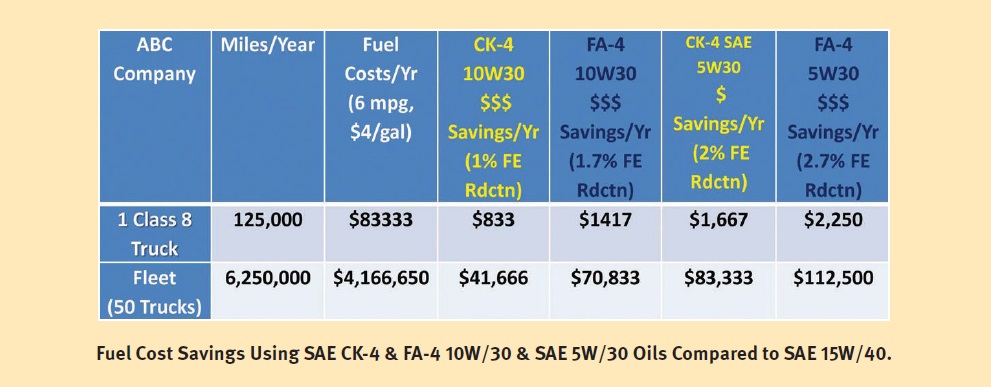 Figure 3. Fuel cost savings using PC-11 oils.
REFERENCES
Figure 3. Fuel cost savings using PC-11 oils.
REFERENCES
1.
From
PC-11 Explained. Available at
http://pc-11explained.com/pc-11-explained.html.
2.
PC-11s with synthetic base oil are expected to make up only a very small percent¬age of the PC-11 market, but as technologies evolve that may change.
 Jeanna Van Rensselar heads her own communication/public relations firm, Smart PR Communications, in Naperville, Ill. You can reach her at jeanna@smartprcommunications.com
Jeanna Van Rensselar heads her own communication/public relations firm, Smart PR Communications, in Naperville, Ill. You can reach her at jeanna@smartprcommunications.com.